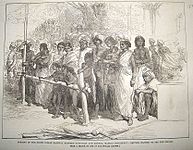South Indian Railway Company
Trichinopoly, Madras Presidency, British Raj (Operations) | |
| Reporting mark | SIR |
|---|---|
| Locale | Madras Presidency |
| Dates of operation | 1 July 1874–13 April 1951 (76 years, 9 months and 13 days) |
| Predecessor | Great Southern Railway of India Carnatic Railway |
| Successor | Southern Railway zone |
| Technical | |
| Previous gauge | 1,000 mm (3 ft 3+3⁄8 in) |
The South Indian Railway Company operated a number of
from 1874 to 1951.History
The Great Southern of India Railway Company was established with its headquarters in
Southern Railway zone of the Indian Railways
.
-
Opening of theTuticorin and Madura by Madras Presidency. "Natives waiting to see the Prince in 1876"
-
An up-country railway station
Rolling stock

By the end of 1877 the company owned 97 steam locomotives, 366 coaches and 1643 goods wagons.[4] By 1936, the rolling stock had increased to 557 locomotives, 27 railcars, 1610 coaches and 9779 freight wagons.[5]
Classification
It was labeled as a Class I railway according to
Conversion to broad gauge
The railway lines were converted to
broad gauge in the 1990s[citation needed
].
See also
- 1928 South Indian Railway Strike
- Southern Railway zone
References
Notes
- ^ South Indian Railway Company 2015, Chapter 1.
- ^ a b "Indian Tramway Limited". Herepath's Railway and Commercial Journal. 32 (1595): 3. 1 January 1870.
- ^ Report on the Administration of the Madras Presidency During the Year 1875-76. Government Press. 1877. p. 260.
- ^ Archiv für Post und Telegraphie, Band 7 (in German). Reichsdruckerei, Berlin. 1879. p. 62–63.
- ^ World Survey of Foreign Railways. Transportation Division, Bureau of foreign and domestic commerce, Washington D.C. 1936. p. 219.
- ^ "Indian Railway Classification". Retrieved 10 November 2022.
- ^ World Survey of Foreign Railways. Transportation Division, Bureau of foreign and domestic commerce, Washington D.C. 1936. p. 210–219.
Bibliography
- South Indian Railway Company (2004) [1st pub. (1926) Madras: Offices of the SIRC]. Illustrated guide to the South Indian Railway (Incorporated in England): including the Tanjore District Board, Pondicherry, Peralam-Karaikkal, Travancore State, Cochin State, Coimbatore District Board, Tinnevelly-Tiruchendur, and the Nilgiri Railways. New Delhi: Asian Educational Services. ISBN 8120618890.
- South Indian Railway Company (2015) [1st pub. (1900) Madras: Higginbotham & Co]. The Illustrated Guide to the South Indian Railway. Stroud, Gloucestershire, England: Amberley Publishing. ISBN 9781445650814.
- Subramhanyan, S (2010). Marvels of the South Indian Railway: 1859 - 1951. Tiruchchirappalli: Railway Heritage Centre, Southern Railway, Tiruchchirappally Division. ISBN 9788192146607.
External links
Wikimedia Commons has media related to South Indian Railway.


